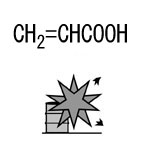| Case Name |
Explosion of acrylic acid in the drum can in the heating cabinet for dissolution |
| Pictograph |

|
| Date |
March 6, 1998 |
| Place |
Kakogawa, Hyogo, Japan |
| Location |
Chemical factory |
| Overview |
To dissolve acrylic acid used for manufacturing ultraviolet curing resin, three drum cans were heated in a heating cabinet. As one of them had swollen unusually, it was going to be taken. At that moment, gas blew off. Water was sprayed using an indoor fire hydrant, but the drum can exploded during cooling. It made contact with direct steam piping. Therefore, a hot spot was generated and an abnormal reaction occurred. It seems that this accident was caused by insufficient recognition of the hazards of acrylic acid of workers, or insufficient safety equipment. |
| Incident |
To dissolve acrylic acid used for manufacturing ultraviolet curing resin, three drum cans containing acrylic acid were heated in a heating cabinet. One drum can had swollen unusually. When it was going to be taken out, gas blew off. During spraying water for cooling with an indoor fire hydrant, an explosion occurred. |
| Processing |
Manufacture |
| Individual Process |
Dissolution |
| Substance |
Acrylic acid, Fig2 |
| Type of Accident |
Rupture, explosion |
| Sequence |
Drum cans of acrylic acid and epoxy resin were carried into a heating cabinet.
One of three acrylic acid drum cans had swollen unusually.
When the drum can was going to be taken out, gas blew off from the drum can.
Water was sprayed with an indoor fire hydrant, and the drum can was cooled.
22:42 on March 6th, 1998. The drum can exploded and three persons were injured.
22:44. The fire department was notified. Four fire engines and 13 fire fighters turned out.
22:51. The fire was extinguished. |
| Cause |
One of the three drum cans put into a heating cabinet touched steam piping for heating. Therefore, the temperature of the contacting part became high and acrylic acid inside caused a polymerization reaction. As a liquid was evaporated by reaction heat, the pressure in the drum rose, and it eventually exploded. |
| Response |
Water was sprayed from an indoor fire hydrant to cool the drum can.
The injured were evacuated.
The public fire department was notified. |
| Countermeasures |
Stopping dissolution work at the factory. Carrying in materials in a dissolved state.
Preparing a procedure document for using acrylic acid.
Educating and training operators. |
| Knowledge Comment |
If the heating temperature is not so much higher than the melting point, the temperature of a dissolution part is maintained at the same temperature as the near melting point by convection and conduction. However, if the heating temperature is rather high or a heat source is contacted directly for rapid dissolution, the temperature of the dissolved liquid and places near the contact part will become higher than the melting point. If the material is thermally unstable, a reaction will be caused. If possible, improvement in equipment should be prior to dependence on human attention. |
| Background |
The problem is whether the administrator understood the hazard of raising the temperature of acrylic acid, and whether the equipment was appropriate for it. Installing of a partition might be sufficient so that a steam pipe should not make a direct contact. The cause was considered human error if the workers had been educated on the hazard. However, equipment should be inproved, too. Inconsistent safety management might be considered. |
| Incidental Discussion |
Although the same thing can be said of every phenomenon, countermeasures after an accident are more serious than those considered and prepared initially. To prevent the accident like this, dissolution work at a factory was stopped and dissolved materials were carried in. However, there might be a new problem that the cost increases or the dissolved materials solidify after being received at the factory and so on. |
| Reason for Adding to DB |
Example of explosion caused due to an abnormal reaction from a hot spot made by a direct contact with a hot section |
| Scenario |
| Primary Scenario
|
Organizational Problems, Inflexible Management Structure, Insufficient Education/Training, Poor Value Perception, Poor Safety Awareness, Inadequate Risk Recognition, Insufficient Analysis or Research, Insufficient Practice, Lack of Imagination, Planning and Design, Poor Planning, Poor Design, Regular Movement, Careless Movement, Contact With Steam Piping, Bad Event, Chemical Phenomenon, Abnormal Reaction, Failure, Large-Scale Damage, Rapture, Secondary Damage, External Damage, Explosion, Bodily Harm, Injury, 3 person injured
|
|
| Sources |
Fire and Disaster Management Agency, Explosion when heating raw material at the manufacturer. Accident cases of dangerous materials. 1998, pp.86-87.
Outline of significant accidents in 1998. Safety yearbook, p.272.
The Res. Inst. of Industrial Safety material. (closed).
|
| Number of Injuries |
3 |
| Physical Damage |
Complete collapse of a heating cabinet. Slight damage to two buildings including an adjoining office. Windows were broken on the north side and east side within a radius of about 15 m. |
| Financial Cost |
¥ 3 million. (Fire and Disaster management Agency) |
| Multimedia Files |
Fig2.Chemical formula
|
| Field |
Chemicals and Plants
|
| Author |
ITAGAKI, Haruhiko (Japan National Institute of Occupational Safety and Health)
TAMURA, Masamitsu (Center for Risk Management and Safety Sciences, Yokohama National University)
|
|